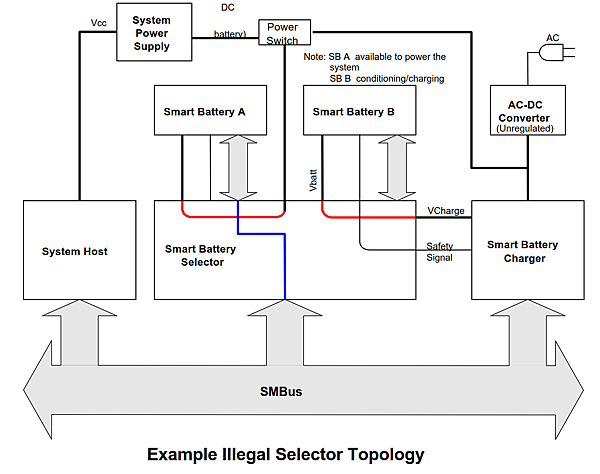本篇寫的是Smart Battery Selector Specification Revision 1.1 第4章的內容翻譯
主要是講概論的,若要看指令請參下篇
原文可去SBS官方論壇下載:http://www.sbs-forum.org/specs/
====
最近在看Smart Battery Selector Specification Revision 1.1
這文件只有22頁,前面4頁還是封面跟目錄 ![]()
說真的跟另外兩個spec(charger spec,39頁 跟 data spec,59頁,)比起來,這篇是最短的
不過第4章不翻譯的話實在太難讀了,有看沒有懂
索性自己來做翻譯,順便當作讀書筆記
不然每次看一遍都要再立刻翻一遍
時間也沒省到哪
話說一翻下去才發現為什麼這麼難讀-.-
因為這份spec的構句常涉及多個元件,導致複雜度比其他的spec高了一個層級
所以直接翻很難看懂
貼在這邊,若有需要的人可以自行取用
其他章節比較簡單,暫時就不翻了~
中文部分是從spec.的第四章全部copy,一句一句翻的
翻譯是先用google翻譯翻個粗稿
然後再自己把奇怪的句子調整成人看得懂的版本(至少調成我看得懂的句子)
下面的翻譯對應文件的p.6~p.12
有的太難翻的,後面會加註『翻譯困難,請自行參酌』
有的部分若中文讀起來怪怪的,請以英文為主,自行翻譯
若有翻譯高手路過,也可指教
不過不要吐酸水~謝謝~
==================
4. Smart Battery Selector 智能電池選擇器
Why is a Smart Battery Selector necessary? It would seem that the obvious method for adding an additional Smart Battery to any system would be simply to allocate an additional SMBus address for the second battery.
為什麼需要智能電池選擇器?添加一個額外的智能電池到任何系統的明顯方法,似乎只是為第二個電池分配一個額外的SMBus地址。
Unfortunately, this is not practical; the SMBus address is merely one part of the system, defining the data path for smart battery data transactions between the system host, the charger and the battery itself. Other significant connections are required.
不幸的是,這是不切實際的(不可行)。 SMBus地址只是系統的一部分,它定義了系統主機(system host),充電器和電池本身之間進行智能電池數據交易的數據路徑。但還需要其他重要(有意義的)連接。
In most multiple-battery systems today, some device or mechanism must be present to arbitrate between the batteries. Additionally, this device must be able to dynamically re-configure the system’s power with sufficient speed to prevent any negative side-effects caused by removal of the system’s primary battery. A user may neither know nor care which battery is powering the system, but the user does expect that the system will keep on working.
在當今的大多數多電池系統中,必須存在一些裝置或機制在電池間進行仲裁(arbitrate)。此外,此設備必須能夠以足夠的速度動態地重新配置系統的電源,以防止由於卸下系統的主要(primary)電池而造成的任何負面影響。用戶可能不知道也不在乎哪個電池為系統供電,但是用戶確實預期系統會繼續工作。
For example, in a system where a slot is shared between a battery and a floppy disk drive, the user may simply remove the battery to install the floppy drive. If this example system was powered by the battery in the shared slot, the Smart Battery Selector must be able to switch to the other battery quickly enough that the system’s power integrity is not compromised.
例如,在一個電池和軟盤驅動器(floppy disk drive)共享插槽的系統中,用戶只需卸下電池即可安裝軟盤驅動器。如果這個例子系統由共享插槽中的電池供電,智能電池選擇器必須能夠以足夠快的速度切換到另一個電池,以確保系統的電源完整性不受損害(連累)。
The system’s power management must also be informed that there has been a change in the SelectorState().
還必須通知系統的電源管理在SelectorState()中發生了更改。
The Smart Battery Selector must have the ability to notify the system (preferably via an SMBALERT signal) that a change has occurred so the system can get updated information as required.
智能電池選擇器必須具有通知系統更改已發生了的能力(最好通過SMBALERT信號),因此系統可以根據需要獲取更新的信息。
The battery selector described in this specification can provide this level of functionality.
本規範中描述的電池選擇器可以提供此級別的功能。
4.1. Smart Battery Selector Requirements and Considerations
智能電池選擇器要求和注意事項 (考量)
There are several requirements for a system operating from battery power in a multiple-battery system. If these are not considered, there may be undesired consequences ranging from bad data to potentially dangerous operating conditions.
對於使用多電池系統中的電池電源運行的系統有一些要求。 如果不考慮這些因素,可能會產生不良後果,包括不良(或錯誤)數據,甚至是潛在的危險操作條件。
When operating from either battery or AC power: 使用電池或交流電源供電時
• Any request that will result in an invalid selector topology will be ignored. For example, using SelectorState() to request two batteries to power the system at the same time will be rejected.
•任何會導致選擇器拓撲無效的請求都將被忽略。 例如,使用要求兩個電池同時為系統供電的SelectorState()將被拒絕。
• SelectorState() will always return the actual state of the selector. Software may use this feature to verify that a previous request was valid.
•SelectorState()永遠會返回選擇器的實際狀態。 軟體可能會使用此功能來驗證先前的請求是否有效。
When operating from battery power: 使用電池供電時
• The power output of the battery in use must be connected to the system power supply and the power output of the unselected battery must be isolated from the system power supply. This is necessary to prevent potentially high-current conditions that can occur if two or more batteries with different characteristics or states are simply connected together.
•使用中的電池的電源輸出必須連接到系統電源,並且,未被選擇的電池的電源輸出必須與系統電源隔離。 這對於防止兩個或多個具有不同特性或狀態的電池連接在一起,而可能發生高電流的情況,是必須的。
• The SMBus connection from the battery in use must be directed to the system host and the SMBus connection from the unselected battery must not interfere with the operation of the battery in use.
This ensures the integrity of critical messages between the battery in use and the host. “Critical” messages from the unselected battery are by definition not critical in this context. If there are critical messages from the battery to the charger, they will be sent through the data path linking the charger and the battery.
•使用中的電池的SMBus連接必須被連向系統主機,並且,未選擇的電池的SMBus連接不得干擾使用中的電池的運行。 這確保了正在使用中的電池和主機之間的『重要訊息』的完整性。 從未被選擇的電池來的『重要』訊息,從定義上講,在此情況下是『不重要的』。 如果有從電池到充電器的『重要』訊息,它們將通過連接充電器和電池的數據路徑發送。
• The host must be able to communicate with any battery NOT powering the host (unselected) to determine capacity, etc., without interfering with the normal operation of the selected battery. This feature enables displays that show the condition of every battery in the system, not just the active one.
•主機必須能夠與任何此時不為主機供電(未被選擇的)的電池進行通信,以確定容量等,而不干擾被選擇的電池的正常運行。 這個功能使顯示器可以顯示系統中每個電池的狀態,而不僅僅只有活動中的電池。
• The selector should provide switch-over functions to autonomously switch between batteries to prevent system failure. In a two-battery system, if the battery in use fails or is removed, the other battery mustbe selected immediately, without host intervention, and without compromising safety.
•選擇器應提供切換功能,以在電池之間自動切換,以防止系統錯誤(失效,failure)。在雙電池系統中,如果使用中的電池發生故障或被取出,則另一個電池必須在無需主機干預,也不影響安全性的情況下,立即被選擇。
• If the selector determines that the configuration has changed (either autonomously or due to user
intervention, for example, plugging in an AC wall adapter power source), the host must be notified that a change has occurred.
This notification should be independent of the SMBus, for example a state change line, that would cause the host to query the selector’s new SelectorState via the SMBus. The SelectorState change line may be connected either to an SMBALERT or it may be polled. The implementation is at the option of the system’s designer.
An acceptable alternative would be a selector device that becomes a master device and writes its SelectorState register to the host (SMBus WriteWord to the SMBus Host with the command code set to the selector’s address 0x14). In either case, the host is notified by the selector whenever a change occurs.
•如果選擇器確定(determine)配置已更改(自主地,或是由於用戶干預(例如,插入交流牆壁變壓器電源),則必須通知主機發生了變化。 此通知應獨立於SMBus,例如狀態改變線(state change line),這將導致主機通過SMBus查詢選擇器的新SelectorState。 SelectorState改變線可能連接到SMBALERT,也可能被輪詢。 系統的設計者可以自行選擇實施哪一種。 一種可接受的替代方法是,選擇器成為主設備(master),並將其SelectorState暫存器寫入主機(用設置為選擇器地址0x14的指令代碼,使用SMBus WriteWord寫入SMBus主機。)。不管在哪一種情況下,只要發生改變,選擇器都要通知主機。
When operating from an externally supplied power source (AC), there is another set of requirements for amultiple-battery operated system. As in the previous case, there are potentially harmful side-effects if any of the following are ignored while operating from external power:
當使用外部電源(AC)進行操作時,對於多電池操作系統,有另一組要求。 與之前的情況一樣,當使用外部電源工作時,如果以下內容的任何一條被忽略 ,將可能有潛在的有害副作用:
• The power output from both batteries must be able to be isolated from external power. This is necessary to prevent uncontrolled currents into or out of the batteries.
•兩個電池的輸出電源必須能夠與外部電源隔離。 這是防止不可控制的電流流入或流出電池的必要要求。
• The output of the charger must be connected to the appropriate battery. Most (perhaps all) systems will charge the batteries sequentially with only one charger, so the output of that charger must be connected properly.
•充電器的輸出必須連接到適當的電池。 大多數(也許全部)系統將僅使用一個充電器對電池依次充電,因此必須正確地(適當的)連接充電器的輸出。
• The SMBus connection from the battery selected for charging must be connected to the charger’s SMBus connection and the SMBus connection from the unselected battery must be isolated from the charger. Because the smart battery uses SMBus commands to properly configure the charger, this data path must match exactly the power path of the charger. It could compromise safety if battery A is connected to the charger power output while battery B is controlling the charge conditions.
•被選擇用於充電的電池的SMBus接點必須被連接到充電器的SMBus接點,並且,未被選擇的電池的SMBus接點必須與充電器隔離。 由於智能電池使用SMBus命令來正確地配置充電器,因此該數據路徑必須與充電器的電源路徑完全匹配。 如果在電池B控制充電條件的時候,電池A連接至充電器的電源輸出,則可能會危及安全性。
• The selected battery’s Safety Signal must be connected to charger. The Safety Signal is the fail-safe temperature monitor for charging. Failure to connect the proper Safety Singal to the charger defeats the fail-safe arrangement. (For further information regarding the Safety Signal, refer to the Smart Battery Data Specification and Smart Battery Charger Specification.)
•被選擇的電池的安全信號必須連接到充電器。 安全信號是用於充電的故障安全溫度監控器。 未能正確的將安全信號連接到充電器,將會破壞故障安全安排(fail-safe arrangement)。 (有關安全信號的更多信息,請參閱《智能電池數據規範》和《智能電池充電器規範》。)
• The selector must select the proper battery immediately when external power is removed or fails. This must be done autonomously and the SelectorState change mechanism asserted to notify the system host.
•當外部電源斷開或出現故障時,選擇器必須立即選擇合適的電池。 這個必須自主完成,並且,SelectorState更改聲稱的機制,以通知系統主機。(翻譯可能有誤)
Any topology that is in conflict with the above requirements has the potential for incorrect or dangerous operation and is therefore unacceptable. Selectors that allow topologies that are in conflict with the above are NOT compliant with the Smart Battery System specifications.
與上述要求衝突的任何拓撲,都可能導致錯誤或危險操作,因此是不可接受的。 任何允許與上述衝突的拓撲的選擇器,都不符合智能電池系統規範。
The following diagram illustrates an example of an illegal topology. In this case, Battery B is connected to the charger’s power output (the dashed line), but the SMBus (solid line) is connected to Battery A.
下圖描述了一個非法拓撲的示例。在這種案例下,電池B已連接到充電器的電源輸出(虛線),但SMBus(實線)連接到電池A。
Such a situation could arise if the system had selected Battery B to be charged, therefore connecting the charger’s power output and SMBus to Battery B, and at some later time changed the SMBus connection to Battery A in order to read Battery A’s capacity. (Note that in this example implementation the host and charger are always on the same SMBus segment.)
這種非法拓樸的情況可能會出現在如下的狀況:如果系統選擇了電池B進行充電,因此充電器的電源輸出和SMBus連接到電池B,並在之後的某個時間,SMBus連接更改到電池A,以讀取電池A的電量。 (請注意,在此示例實現中,主機和充電器總是在同一SMBus網段上。)
If the host then crashes before switching the SMBus connection back to Battery B, Battery A’s charging current and voltage requests will be interpreted by the charger as coming from Battery B.
如果在將SMBus連接切換回電池B之前,主機(host)隨後崩潰(crash),充電器會將電池A的充電電流和電壓請求解釋為來自於電池B。
Clearly, this dangerous situation must be avoided; for this type of topology the selector must not allow the charger to supply power to one battery while communicating with another. (Of course, the battery pack’s internal protection circuitry should avert any dangerous situation, but it should never be relied on as part of the “normal” safety system.)
顯然,必須避免這種危險情況;對於這種類型的拓撲,選擇器不得允許充電器在與另一個電池通訊時為其供電。 (當然,電池組的內部保護電路應該會避免任何危險情況,但絕對不應依賴此安全機制,將其作為“正常”安全系統的一部分。)

To accomplish these tasks, the selector can be thought of as a device that controls a collection of five data and power switches:
為了完成這些任務,可以將選擇器視為控制五個數據和電源開關的集合的設備:
• System input power
• Charger output power
• Battery-to-charger data
• Battery-to-charger Safety Signal
• Host-to-battery data
•系統輸入電源
•充電器輸出電源
•電池到充電器數據
•電池到充電器安全信號
•主機到電池數據
Note: See the discussion in section 6.3 for special recommendations for a combined selector and charger component.
注意:有關將選擇器和充電器合在一起的組件的特別建議,請參見第6.3節中的討論。
==========
為避免篇幅太長
4.2~4.4 請參下一篇


 留言列表
留言列表


